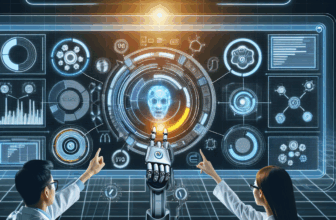Transforming Customer Experience: The Benefits of AI-Powered Intelligent Chatbots
Table of Contents
- 1. Introduction to AI-Powered Intelligent Chatbots
- 2. Understanding the Technology Behind Intelligent Chatbots
- 2.1 Natural Language Processing (NLP)
- 2.2 Machine Learning and AI Models
- 2.3 Integrations with Other Technologies
- 3. Benefits of AI-Powered Intelligent Chatbots
- 3.1 Enhanced Customer Support
- 3.2 Cost Efficiency
- 3.3 24/7 Availability
- 3.4 Improved Customer Engagement
- 4. Real-Life Applications and Case Studies
- 5. Challenges and Ethical Considerations
- 6. Future Trends in Chatbot Technology
- 7. Frequently Asked Questions (FAQ)
- 8. Conclusion
1. Introduction to AI-Powered Intelligent Chatbots
In an increasingly digital world, customer experience is one of the critical differentiators for businesses aiming to thrive. The rapid integration of artificial intelligence (AI) into customer service operations heralds a new era, drastically transforming how businesses engage with customers. Central to this innovation is the rise of AI-powered intelligent chatbots.
Unlike traditional chatbots, which often rely on pre-defined rules and simple keyword recognition, intelligent chatbots use sophisticated algorithms and machine learning (ML) capabilities to understand, respond to, and learn from customer interactions in a more human-like manner. These tools not only provide immediate responses but also analyze customer data and behavior to deliver personalized experiences.
This article delves into the transformative potentials of AI-powered intelligent chatbots, detailing their functionalities, benefits, real-life applications, challenges, and future trends to help businesses shape their customer experiences more effectively.
2. Understanding the Technology Behind Intelligent Chatbots
For a comprehensive understanding of AI-powered intelligent chatbots, it's essential to explore the underlying technologies that empower these tools. This section dissects the key components that contribute to their intelligence and functionality.
2.1 Natural Language Processing (NLP)
Natural Language Processing (NLP) is a crucial technology that allows machine comprehension and interaction in human language. By utilizing NLP, chatbots can interpret user input, understand context, and generate relevant responses.
NLP encompasses several sub-disciplines, including syntax, semantics, and pragmatics. For instance, syntax helps the chatbot understand grammar, while semantics assists in grasping the meaning of words and phrases based on context. By leveraging these aspects, AI-powered chatbots can manage complex conversations and deliver precise responses.
Companies like Google and IBM have invested heavily in NLP. Google's Dialogflow, for example, uses advanced NLP techniques to facilitate seamless interactions in various languages, making it a powerful tool for businesses worldwide.
2.2 Machine Learning and AI Models
Machine learning algorithms enable intelligent chatbots to analyze large datasets, identify patterns, and adapt over time. This capability allows chatbots to improve their responses and enhance user satisfaction systematically.
Through training on historical customer interaction data, chatbots can learn which resolutions lead to successful outcomes, ultimately refining their forecasting abilities and ensuring that users receive relevant responses.
Companies like Amazon employ sophisticated machine learning models within their chatbots. These models analyze customer purchase history to predict future buying behaviors and suggest relevant products proactively.
2.3 Integrations with Other Technologies
To operate effectively, intelligent chatbots often integrate with various systems and technologies, such as Customer Relationship Management (CRM) systems, databases, and even social media platforms.
By connecting with CRM systems, chatbots can pull customer data swiftly and provide tailored assistance based on previous interactions. Furthermore, these integrations facilitate seamless handoffs between chatbots and human agents, ensuring a smooth customer journey regardless of complexity.
A prime example is Zendesk, which offers an AI-driven chatbot that integrates with numerous third-party applications to streamline customer support processes.
3. Benefits of AI-Powered Intelligent Chatbots
The implementation of AI-powered intelligent chatbots can yield several substantial benefits for businesses. This section unpacks the main advantages these technologies offer in enhancing customer experience.
3.1 Enhanced Customer Support
AI-powered chatbots significantly improve customer support by providing fast, accurate, and relevant responses to inquiries. Unlike traditional support systems, which may lead to long wait times, intelligent chatbots can handle multiple queries simultaneously, ensuring every customer receives swift assistance.
Moreover, these chatbots can address a multitude of issues, from basic FAQs to complex troubleshooting, leading to improved problem resolution rates. Their capability to scan vast heaps of data allows them to recognize patterns and predict frequently encountered customer issues, further refining their support capabilities.
A notable example is H&M's chatbot, which assists customers in navigating clothing selections, checking products, and providing styling tips, all through conversational interfaces, thus elevating the shopping experience.
3.2 Cost Efficiency
Businesses continuously seek ways to reduce operational costs without compromising quality—AI-powered chatbots excel in this regard. By automating routine tasks and inquiries, organizations can significantly decrease labor costs associated with customer service.
The savings extend beyond staffing, as chatbots mitigate the need for extensive physical infrastructure to support traditional customer service operations. Additionally, they can substantially reduce overhead expenses related to training costs.
A study by Juniper Research suggests that chatbots will save businesses approximately $8 billion by 2022 by facilitating customer interaction more cost-effectively than human agents.
3.3 24/7 Availability
One of the most compelling advantages of AI-powered chatbots is their round-the-clock availability. Unlike human agents bound by traditional working hours, chatbots can provide assistance 24/7, which is vital in today's global marketplace.
This constant availability ensures that customers can receive support when needed, irrespective of time zones or differing schedules. Consequently, businesses can improve customer satisfaction, enhance brand loyalty, and even capture sales opportunities that would have otherwise been lost.
For instance, Domino's Pizza has successfully integrated a chatbot that allows customers to place orders at any hour, substantially increasing their service reach and revenue generation.
3.4 Improved Customer Engagement
Intelligent chatbots play a pivotal role in enhancing customer engagement through personalization and interactivity. By leveraging customer data, chatbots can deliver tailored experiences, enhancing user interaction and fostering deeper relationships with the brand.
Engaging customers consistently through surveys, recommendations, and follow-up messages creates an ongoing dialogue that nurtures brand loyalty and encourages repeat business. These proactive interactions make customers feel valued and understood, enhancing their overall experience.
Starbucks' chatbot exemplifies this engagement strategy, providing personalized offers and rewards based on user behavior, thereby encouraging app usage and customer loyalty.
4. Real-Life Applications and Case Studies
Real-life implementations of AI-powered intelligent chatbots underscore their transformative potential across various business sectors. This section highlights notable case studies exemplifying effective chatbot applications in diverse industries.
Case Study 1: Sephora
Sephora, a leading beauty retailer, has employed an AI-driven chatbot integrated with its mobile app. The chatbot assists customers in finding products, receiving personalized recommendations, and even booking in-store appointments. The intelligent system analyzes individual preferences, leading to positive shopping experiences. Customer feedback highlights that 70% of users appreciate the chatbot's ability to personalize product suggestions based on historical preference data.
Case Study 2: KLM Royal Dutch Airlines
KLM Royal Dutch Airlines integrated a chatbot within its customer service platform for answering queries related to flight status, booking details, and baggage information. The chatbot efficiently handles thousands of inquiries per day, providing instant responses through various messaging platforms. As a result, KLM reported a substantial reduction in query resolution times and increased overall customer satisfaction ratings.
Case Study 3: Whole Foods Market
The online grocery retailer Whole Foods utilizes a chatbot that assists customers in product selection, recommendations, and recipe ideas. Integrated with Facebook Messenger, the chatbot also allows users to make purchases directly through the platform. The convenience of accessing product information and shopping in a conversational interface has positively impacted user engagement and purchase frequency.
5. Challenges and Ethical Considerations
While AI-powered intelligent chatbots offer numerous benefits, they also pose certain challenges and ethical considerations that organizations should address. This section examines these critical aspects.
5.1 Data Privacy Concerns
The collection and analysis of customer data enable chatbots to deliver personalized experiences. However, this practice raises significant data privacy concerns. Organizations must ensure compliance with data protection regulations such as GDPR and CCPA to protect customer information and maintain trust.
Consumers are increasingly wary of corporations that mishandle their data, leading to reputational damage and potential legal repercussions. Businesses must adopt robust data management practices to ensure that customer information is used transparently and ethically. This includes obtaining informed consent and providing customers with control over their data.
5.2 Accuracy and Reliability
While advances in AI and machine learning enhance chatbot performance, issues surrounding accuracy and reliability persist. Customers should receive precise, relevant answers; otherwise, frustration may arise, potentially damaging brand perception.
Businesses must invest in continuous training and refinement of chatbot algorithms to minimize errors and improve reliability. This could include human oversight and intervention, especially in complex decision-making scenarios that require nuanced understanding.
6. Future Trends in Chatbot Technology
Advancements in technology suggest continuous evolution in chatbot capabilities and functions. This section highlights some promising future trends in AI-powered chatbots.
Expansion of Multimodal Interfaces:
Future chatbots may utilize multimodal interfaces that combine text, voice, and visual inputs for more comprehensive interactions. Such enhancements could allow users to engage through voice commands, video, and even augmented reality experiences, creating hyper-personalized touchpoints.
Heightened Emotional Intelligence:
Advances in emotional intelligence capabilities may enable AI chatbots to better understand user emotions and respond accordingly, further enhancing user engagement. By recognizing keywords, tone, and sentiment, chatbots could deliver empathetic responses that feel more genuine.
Greater Industry-Specific Customization:
Increased industry-focused capabilities may allow businesses to deploy highly customized chatbots tailored to specific sectors. Healthcare, finance, e-commerce, and other areas could see more specialized solutions capable of meeting their unique requirements.
Enhanced Integration with IoT Devices:
The proliferation of IoT devices may lead to chatbots that interact seamlessly with smart home technologies, wearables, and other connected devices. This integration can offer users comprehensive management systems, providing data-driven insights and recommendations.
7. Frequently Asked Questions (FAQ)
This section addresses some common inquiries regarding AI-powered intelligent chatbots to provide further clarity on the subject.
- Q: What is the primary function of an intelligent chatbot?
- Q: How do chatbots improve customer satisfaction?
- Q: What are the operational costs associated with implementing a chatbot?
- Q: Are chatbots capable of handling complex queries?
A: The primary function of an intelligent chatbot is to simulate human conversation, providing users with real-time responses to inquiries and assistance in tasks without human intervention.
A: Chatbots improve customer satisfaction by delivering immediate responses, personalized interactions, and 24/7 availability, ensuring users feel valued and heard.
A: Operational costs will vary, but initial expenses typically encompass chatbot development, integration with existing systems, and ongoing maintenance. However, the potential savings in customer service costs often outweigh these investments.
A: While intelligent chatbots can handle many inquiries, they may require human intervention for highly specialized or intricate issues. Businesses should ensure a seamless escalation process when necessary.
8. Conclusion
AI-powered intelligent chatbots undeniably transform customer experience across industries, enhancing engagement, efficiency, and satisfaction. By understanding the technology that drives them and their myriad benefits, businesses can better leverage these tools to meet evolving consumer expectations.
As organizations navigate the complexities of implementation, it is vital to address challenges related to data privacy and reliability to sustain customer trust. Additionally, with advancements in technology, understanding future trends can keep businesses at the forefront of innovation and customer service excellence.
In conclusion, embracing AI-powered chatbots is not merely a trend; it is a strategic move that can significantly influence customer relationships and operational efficiency. By continuously updating these systems and aligning them with business objectives, organizations can harness the full potential of chatbot technology to drive their success in a competitive marketplace.
Resources
| Source | Description | Link |
|---|---|---|
| Artificial Intelligence in Customer Service | A comprehensive guide on how AI enhances customer service. | Forbes |
| AI Chatbot: The Ultimate Guide | Explore the fundamentals of AI chatbots and their applications. | Chatbots.org |
| GDPR Compliance for Chatbots | Guidance on ensuring data privacy and compliance for chatbots. | eugdpr.org |
Disclaimer
This article is produced by an AI and is in Beta Testing. The information contained in this article is intended to provide a comprehensive overview of AI-powered intelligent chatbots and their role in transforming customer experience. Readers are encouraged to conduct further research to ensure they have the most up-to-date information.










